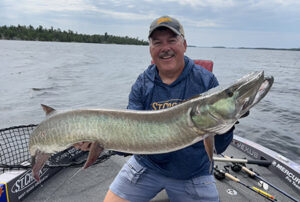By Steve Heiting
Almost every muskie hunter has a favorite lure, but I can’t comfortably claim one for myself. Certainly I have favorite lures for specific conditions, but during the course of a season I see too many different situations to pick just one.
Starting your day with a lure because it’s a favorite can be a huge mistake. I don’t care that it has caught more muskies for you than any other in your tackle box, or it produced your biggest. My credo is the more active muskies I contact the more I’ll catch, so I always pick baits that allow me to cover water fastest, considering the conditions. If fast lures don’t work, I progressively choose slower presentations until I find the one they want.

At the start of a fishing day, look for clues for which bait to choose. Warm conditions typically warrant a fast presentation, whereas cooler conditions call for a slower lure. Likewise, try to “read” the aggressiveness of every following muskie. Fast-moving followers usually can be caught with the same presentation, only with a color or speed change. Lazy followers, or no follows at all, demand you need to fish slower until you find what trips their trigger.
When the water temperature is about 65 degrees or above, the first bait out of my box for the day will be some kind of spinner because it will allow me to cover water fastest. Which bucktail style I choose has everything to do with the location where muskies are holding — the drag produced by different blades lets you easily get your bait to the right depth. If the fish are extremely shallow or the cover is near the surface, a Colorado-bladed bucktail, or a spinner with twin blades, is my pick because it will allow me to fish shallower. If muskies are in mid-depth areas with some kind of weed cover, a bucktail with a French or fluted blade gets the nod. In deeper water, I’ll choose a bucktail with a willow-leaf blade.
After the bucktail in my progression is a tail-spinning topwater, but in low-light conditions it may be my preferred choice. I usually start with a bait with a single tail, but if the fish are extremely aggressive or a big wind is blowing, I’ll switch to a double tail for its larger profile. If a following muskie won’t eat the tail-spinner, I’ll switch to a finesse topwater, either a walk-the-dog type or a Creeper-style. I use the latter two baits only when I know precisely where a fish is holding.
When I expect less-aggressive muskies because of post-frontal conditions or the cooler water temperatures of spring or fall, I usually skip bucktails and topwaters and start the day with a minnowbait. Some models are made to be fished faster while others can be fished more slowly. Minnowbaits are made of plastic or wood, so there’s different buoyancy involved; and some have rounded lips while others have squared lips. Active muskies seem to prefer more buoyant minnowbaits and may respond better to the more violent action of a squared-lip bait, but less aggressive fish may want a lure that’s close to neutrally buoyant or may prefer a rounded-lip bait.
If muskies are following deeply behind my lures, or seem to have completely vacated the shallows, it’s time for crankbaits. Deep divers work by simply being a more in-their-face presentation, and will also trigger reaction strikes from semi-active or inactive fish by bouncing off cover or ticking weed tops. Lure depth can become super-critical in tough conditions — a muskie may not rise up to eat a shallow-running bait, but put one in front of them and watch out.
Glider-style jerkbaits have saved the day for me many times. My favorite conditions for these baits are the first day of a cold front before the skies have cleared, and when the water is cool (spring or fall) but fish are fairly active. I’ll start by fast-hopping them (a fast snapping action of the rod tip to make the bait dart), and eventually slow to a twitch-pause retrieve if quicker movement doesn’t pay off. During the pause, I allow the bait to start sinking before giving it the next twitch.
Diving jerkbaits seem to work for me when gliders do not. Divers vary in buoyancy due to their wood density, but you can add weight to them, too. More buoyant baits need to be fished more quickly to keep them beneath the water’s surface, and thus rank higher on the muskies’ aggression meter. Conversely, a less-buoyant diving jerkbait can be deadly when a lure needs more hangtime to trigger slow-moving fish.
Soft plastics, tubes and jigs usually have no rattles, glide easily through the water, and can be fished more deeply in the water column. All of these factors add up to a highly natural presentation that can be the answer with big muskies that have seen it all, or under tough conditions.
Finally, if I’ve worked my way completely through all the presentation types and still haven’t caught a muskie, I switch back to a bucktail. While this flies in the face of all the post-frontal factors and cold water considerations I’ve discussed so far, a bucktail allows me to cover the most water in the shortest period of time, searching for that one muskie that didn’t get the don’t-bite-today memo. Burning the bucktail can trigger a reaction strike from a muskie that has to make a snap decision whether to eat the bait or get out of the way.
If you pick your baits according to the muskies’ activity or the conditions, you’ll find you won’t have any favorite baits — but you’ll catch more fish.
